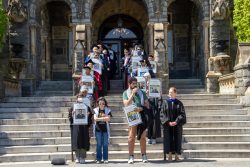When D.C.’s homeless shelters were overwhelmed this winter, the Gray administration’s first response was to blame the victims.
D.C. General—the defunct hospital used as a homeless shelter since 2007—quickly filled up as the ranks of the homeless swelled. As of January, there were more than double the number of people in shelters as the previous year, according to Aaron Weiner’s recent feature in Washington CityPaper.
Since D.C. law requires the city government to house all homeless individuals when the windchill dips below freezing, Gray’s team began placing families in motels. When the number of homeless families continued to climb, the administration concluded the rooms were too enticing for families in need. The homeless chose motels over staying with relatives or friends, they reasoned.
Given that logic, the city began moving homeless families into recreation centers, which offered little in the way of privacy or comfort. Trouble was, housing people there seemed to violate the Homeless Services Reform Act. Lawsuits mounted, and Tuesday a D.C. Superior Court Judge ordered the District to stop housing families in rec centers.
Homeless advocates unsurprisingly see the situation differently from Gray’s team, but they can all agree on one thing—the surge in the homeless population blindsided the District, and that led to the piecemeal approach.
Some of the factors might have been averted, like sequestration cuts to federal housing programs, but there are more entrenched economic issues at play. Put simply, there aren’t enough affordable housing units in the District.
I’ve written recently about possible solutions to gentrification—namely zoning regulations and the encouragement of cooperatively-owned housing—but increasingly, these policies seem insufficient to address the economic realities of housing in American cities.
The main reason so many people in D.C. cannot find housing is that it is no longer profitable for developers to build for them. As architect Roger Lewis explained in the Post, housing construction costs have risen six-fold in the last 30 years. Whereas it used to be worth a developer’s money to build low- and middle-income homes in places like D.C., they now concentrate at the top of the market.
At the same time, the past three decades have played witness to the evisceration of federal housing assistance. The Reagan administration all but eliminated Section 202 loans—used since the late 50’s to provide one-stop financing for developers building affordable units. Now, builders must cobble together loans from a mishmosh of federal, state, and local housing programs, plus attract wealthy individuals seeking tax credits from affordable housing construction—all while swimming upstream against skyrocketing land and construction costs.
“Because the financing process for affordable housing has become so onerous,” Lewis wrote, “it is a disincentive for many housing developers who might otherwise undertake affordable housing construction.”
There is a more comprehensive solution to homelessness and affordable housing. Unfortunately, it is largely taboo in today’s political dialogue. That solution is public housing.
That phrase commonly elicits memories of initiatives like Chicago’s Cabrini Green—which began as perhaps the most hopeful public housing project and ended as the nation’s most infamous. Cabrini, like the vast majority of public housing, was a product of postwar liberalism, a profound extension of the American social contract to include the right to adequate housing.
The good intentions soured quickly in Chicago and elsewhere. Almost as soon as they were constructed, housing projects and their surrounding communities saw their budgets and services slashed. Predominantly white officials found it too easy to deprive the largely black public housing constituency of police protection and job training. Especially once crack cocaine hit the streets, housing projects became the stuff of political legend immortalized in heartwrenching non-fiction works like There Are No Children Here.
Given that history, it’s clear not many policymakers are looking at public housing as a possible solution to the housing crisis. What’s also clear, however, is there aren’t other good options. The economics of housing today all but preclude the private sector from building affordable units. That means government is going to have to do it.
Of course, public housing is more complicated than simply buying land and building high-rises. D.C. would have to couple any efforts with enhanced job training opportunities, community policing, and good local schools to prevent a repeat of last century’s mistakes. That sounds expensive, but D.C. had a $321 million budget surplus last year alone, and millions more could come from a decrease in demand for its horribly inefficient homeless programs.
The difficulties of public housing are more complex than this column can fully explain, but the District cannot continue down its current path. We need a paradigm change when it comes to affordable housing in this city, and that probably means we’re going to have to band together and build something.
Be a roommate with Gavin in public housing: gbade@georgetownvoice.com.




